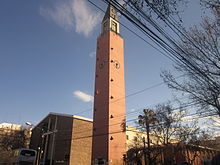San Juan (Argentina)
| Basic data | ||
|---|---|---|
| Surface: | 30 km 2 | |
| location | 31 ° 30 ′ S , 68 ° 30 ′ W | |
| Height above d. M .: | 604 m | |
| Population (2010): | 109.123 | |
| Density: | 3637 inhabitants / km² | |
| Agglomeration : | Gran San Juan | |
|
|
||
| administration | ||
| Province : |
|
|
| Department : | Capital | |
| Mayor: | Marcelo Jorge Lima, Frente para la Victoria | |
| Others | ||
| Postal code : | J5400 | |
| Telephone code: | 0264 | |
| San Juan website | ||
San Juan is a city in western Argentina , located in an oasis in a dry steppe-like area. It is the capital of the province of San Juan . The actual urban area has 109,123 inhabitants (2010, INDEC ), but the development continues in the neighboring departments of Chimbas , Rivadavia , Rawson , Pocito and Santa Lucia , so that the metropolitan area has around 550,000 inhabitants.
geography
San Juan is located at 604 meters above sea level in the southern great oasis of the province, resulting from the valleys of Tullum, Ullum and Zonda east of to precordillera belonging Sierra del Tontal composed.
The Río San Juan flows around the city in the northeast. The surrounding area is steppe-like and consists largely of Monte bush forest, but also of rocky deserts. The climate is dry and subtropical with very high daytime temperatures in summer, in winter the foehn- like Zonda wind often briefly increases temperatures to summery levels.
history
San Juan is one of the oldest cities in Argentina. It was founded in 1561 or 1562 by Juan Jufré in a neighboring valley. In 1594 the city was moved to its current location due to flooding. During the colonial period, San Juan was part of Chile for a while , but with independence it finally fell to Argentina.
In 1826, the Roman Catholic Apostolic Vicariate of San Juan de Cuyo was established, which was elevated to a diocese in 1834 and an archdiocese of San Juan de Cuyo in 1934 .
At the end of the 19th century, the city had a cathedral, mining school, botanical garden, and 15,000 residents who exported cattle and dried fruit to Chile and traded in wine and brandy. The city was the seat of a German consul.
In 1944 an earthquake devastated the city, killing 10,000 people. The reconstruction was shaped by the spirit of the avant-garde architecture of the time - a project by Le Corbusier was rejected, however - and so you can find a large number of modern buildings in the city today.
Architecture and culture
Only a few buildings, including the Dr. Guillermo Rawson and Santo Domingo Convent survived the 1944 earthquake. The 1979 cathedral is a good example of the modern architecture that characterizes the city. The natural science museum houses fossils of prehistoric animals, many of them from the Ischigualasto National Park . The wine museum in an old railroad shed houses historical machines from the region's wineries.
economy
Despite a law that has encouraged the settlement of industrial companies since the 1970s, the city is largely dependent on the agricultural area around the oasis of Tulum. The leading industry is viticulture, which covers 65 percent of the oasis' agricultural area, and the related processing industry. The Ullum reservoir , located in the vicinity of San Juan, is of importance in the energy industry .
Town twinning
Sister cities of San Juan are
- Vicuña , Chile, mutual cooperation agreement since August 3, 2003
- Nerja in Andalusia , Spain, since July 25, 1997
sons and daughters of the town
- Arturo Berutti (1858–1938), composer
- Enrique Pechuán Marín (1913–1983), Roman Catholic clergyman, Bishop of Cruz del Eje
- Mariano Pagés (1922–2009), sculptor
- Vicente Moncho (* 1939), composer
- Ricardo Zunino (* 1949), Formula 1 racing driver
- Julio Largacha (1950–2006), pianist and music professor
- Walter Pérez (* 1975), track and road cyclist
- Rubén Botta (* 1990), Argentinian-Italian soccer player
- Bruno Lima (* 1996), volleyball player
Web links
- IFAM population statistics
- San Juan Newspaper (Spanish)
- Travel San Juan - Tourism (German - English - Spanish)
proof
- ↑ Secretaría de Relaciones Exteriores ( Memento of May 27, 2012 in the Internet Archive )



